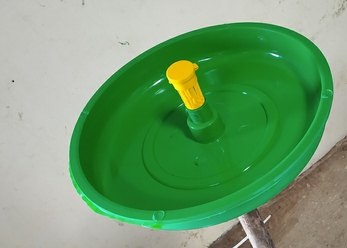




SONKUL AGRO INDUSTRIES PRIVATE LIMITED
Lure With Trap
Pheromone lure of white grub (Holotrichia consanguinea).
The yield loss due to white grub attack on sugarcane is reported to be as high as 80-100 percent in affected areas. this can be prevented with the use of BIO PHERO HC LURE.
Target Crops: Sugarcane, Groundnut, Turmeric, Maize, Bajara, Paddy, Mung, Tur, etc.
Usage Instruction-
Cut opens this pack and slides the lure piece outside.
Do not touch the lure with bare hands.
Fix this lure properly in the Water trap.
Replace the lure at the recommended duration.
Wash hands thoroughly before and after handling the trap and lure.
Discard used lure by burning or burying underground.
Trap to be used: Water trap
No. of Traps/Acre: 5 - 6Life of lure: 60 days
Contents:
Pheromone lure of Holotrichia consanguinea
Identification-
White grubs are the white, soft-bodied larvae of several scarab beetle species, including European chafer, Japanese beetle, and May/June beetles. They have a brown head and six well-developed legs.
When the turf is lifted and grubs are exposed, they tend to be lying on their sides in a C-shaped position. From May through early June, white grubs pupate 2 – 5″ deep in the soil.
Adults emerge from pupae a few weeks later. Signs of white grub damage include wilting or yellowing of grass and can result in large patches of dead crops.
Life Cycle-
Normally in India, adult beetles emerge from the soil during April-June in response to the first seasonal rains.
The adult beetle lays its eggs in the ground during the summer.
As the grubs hatch, they start feeding on the roots until cold weather drives them 2 to 8 inches deeper into the soil where they overwinter.
When spring arrives, the grubs move up from the lower soil regions and resume feeding near the surface until they become mature and pupate from May through early June.
Nature Of Damage-
The white grub and adult feed on the living roots and later adults feed on shrubs and the plants like neem growing near the fields.
The young grubs after hatching in the soil head towards the roots and start feeding on them.
Consequent to feeding, the plants show varying degrees of yellowing. S
ome get wilted and ultimately die. Such affected plants easily collapse.
The adult beetles strip the foliage of the shade trees, crop plants, or any forest trees.
The yield loss due to white grub attack on sugarcane is reported to be as high as 80-100 percent in affected clumps.
The adults feed on the host trees remaining on the borders of the sugarcane crop.
Target Crops: Sugarcane, Groundnut, Turmeric, Maize, Bajara, Paddy, Mung, Tur, etc.
Usage Instruction-
Cut opens this pack and slides the lure piece outside.
Do not touch the lure with bare hands.
Fix this lure properly in the Water trap.
Replace the lure at the recommended duration.
Wash hands thoroughly before and after handling the trap and lure.
Discard used lure by burning or burying underground.
Trap to be used: Water trap
No. of Traps/Acre: 5 - 6Life of lure: 60 days
WATER TRAP-
consists of a water trough and a lure holder with a canopy for the pheromone which attracts specific insects. It is easy to assemble on a single pole.
Insects attracted to pheromones fall into the water in the trough, drown, and die. The trap needs to be set up at a height of 3 - 4 feet from ground level for maximum impact. Fill half the trough with water or water mixed with oil or an insecticide and fix the lure into the holder.
The dead insects can be removed from the trap at appropriate intervals and the tub refilled with water or water mixed with oil or an insecticide.
The frequency of clearing the trap depends on the number of catches and level of infestation.